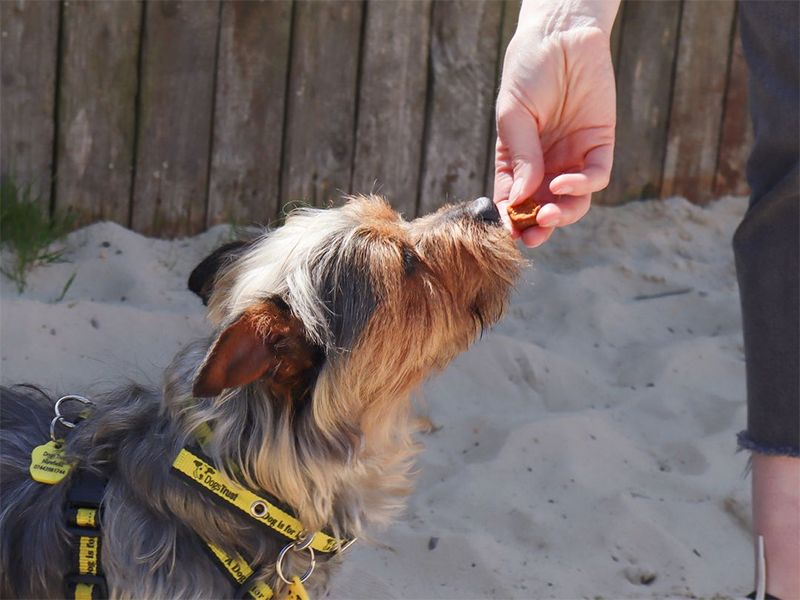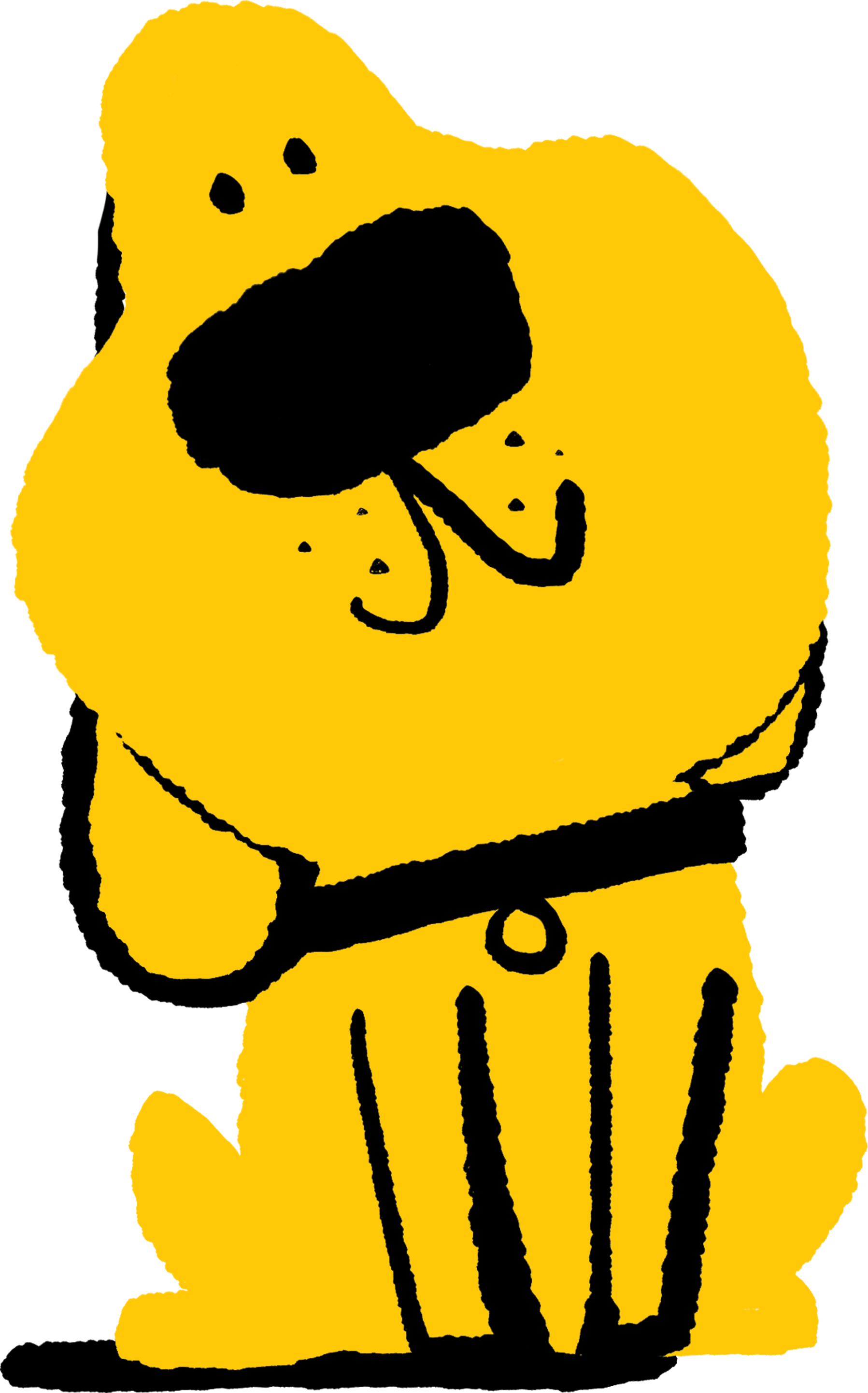Positive reinforcement – training with rewards
Teaching your dog that good things happen when they make good choices.

Positive reinforcement training means training with rewards, such as a treat, praise or a toy. You give your dog something they want when they’re behaving in a way that you like. Then, they’ll be more likely to behave in that way in the future.
Training with rewards is all about teaching your dog that good things happen when they make a good choice.
When your dog does something – such as raising a paw – then gets a reward, they’ll associate the two. They’ll be more likely to repeat the behaviour in future.
Why do we recommend training with rewards?
Training with rewards is the best way to encourage your dog to behave as you would like. For example, learning to settle themselves down when people are busy, instead of looking for attention. The reasons to train your dog in this way include:
- science tells us that reward-based training is the best way for dogs to learn
- training with rewards is fun, and helps build a positive bond between dog and owner
- owners that train using rewards report fewer behaviour problems in their dogs
- reward-based training can help build confidence and encourage dogs to think for themselves.
How to train your dog using positive reinforcement
Start by finding a reward that your dog really likes. This could be being groomed, playing in water, going off-lead during walkies, foraging for treats in a cardboard box, or travelling in the car. All dogs are different, so they will find different things rewarding. However, most dogs enjoy food, toys and our attention.
Rewarding with food
Whatever you choose needs to be safe for your dog and something they like. If you use food for training, remember to cut down on the amount your dog gets during meals to prevent weight gain.
Treats that dogs especially love (something soft and smelly like cheese, sausage or chicken) can be used as the ‘gold star’ reward when your dog gets something spot on. You can also use these to keep your dog’s focus and attention in environments where there are more distractions. These can be chopped into small pea-sized pieces for training.
Use treats that are less exciting (such as dry dog biscuits or chopped up veg) to reward your dog at times it is easy for them to get it right, for example when practising something they know in quiet environments.
Rewarding with toys
Some dogs really love to play, and you can use a game with toys, such as fetch or tug, to reward them for good behaviour. Make sure you teach your dog how to release toys using reward-based training so that you can get the most out of your sessions.
Rewarding with attention
We often underestimate how valuable our attention is. Most dogs feel good any time we look at, touch or talk to them. This means that we are constantly influencing their behaviour with our attention. Make sure your dog gets your valuable attention for the good choices they make, rather than when they are doing something you don’t want them to.
Rewarding your dog for desired behaviour
Whenever your dog is behaving in a way that you’re happy with, be sure to let them know by giving them a reward. Always use a reward your dog really wants. Think about using rewards such as a gentle fuss, stroke or just speaking calmly to your dog when they’re behaving quietly and calmly so the reward doesn’t get them too excited.
If they’re doing something active, like running straight over to you as soon as you call them, rewarding this with an active and energetic game is a wonderful prize. As long as they’re enjoying it, it’s rewarding.
When to reward your dog
When you start training a new skill, it is important that you reward your dog every time they are successful. When they have learnt the new behaviour and can do it well in a variety of environments, you can change the type of reward you give them.
You won’t need to give them a treat for sitting for the rest of their life, you can say “good dog” instead and occasionally give them a treat as a bonus. For example, when using food to train a new behaviour, it’s useful to reward every time to begin with until your dog really understands what you’d like them to do.
Then once they’re reliably and consistently doing it, reward them every other time, then every third time, and then mix and match when you give the food reward and when you just give them some verbal praise or a fuss. This is so your dog doesn’t know when to expect their favourite type of reward and stays interested.
Get your timing spot on
It’s useful to have a marker which is a signal that tells your dog exactly when they’re doing something that you’re happy about. The marker tells your dog ‘Yes, you’ve got it right and I’m just about to give you a reward’. It must always be followed by the reward so your dog can be confident they’ve got things right. Some people use ‘Yes!’ or ‘Good!’
Find out how to introduce a marker to your positive reinforcement training technique.
Different rewards for different times
There might be times when your dog needs an extra or different reward. Sometimes what your dog found easy in the comfort and calmness of their own home, becomes difficult in a busier environment. What they found rewarding at home is no longer exciting for them outside.
If your dog finds responding to you hard because of distractions, you might need to use something extra tempting in that location. Choose a high-value treat your dog loves, like a piece of boiled chicken, a game or a toy instead.
What if your dog is behaving undesirably?
Think about whether your dog might be getting a reward of some sort in response to their behaviour, even though you may not intend on rewarding them.
For example, if a dog is jumping up at someone who tells them ‘No, get down’ while staring at them and pushing them away, the dog may be rewarded by being spoken to, looked at and interacted with. This means they’ll be more likely to jump up again despite the person thinking that they haven’t given any sort of reward at all.
In these types of situations, think about getting ready to guide your dog into making a good choice. For example, ask them to sit and reward this before allowing them to meet someone. In fact, if they like meeting people then getting to do so can be the reward for keeping their paws on the ground.
You can think about using rewards within the environment to help positively reinforce good behaviour. For example, if your dog loves running off lead, then this can be a reward for walking along nicely on lead for a few paces. Think about all the things your dog enjoys and how you can use them to reward good behaviour. This will mean your dog learns how to behave in a very happy way indeed.
Contact our Behaviour Support Line
Need help with your dog’s training or behaviour? Contact our Behaviour Support Line for free expert advice.
Call us on 03030036666
or
Our free telephone service is open Monday to Friday 8.:30am to 7.:30pm and Saturday and bank holidays 9.:30am to 5pm.



